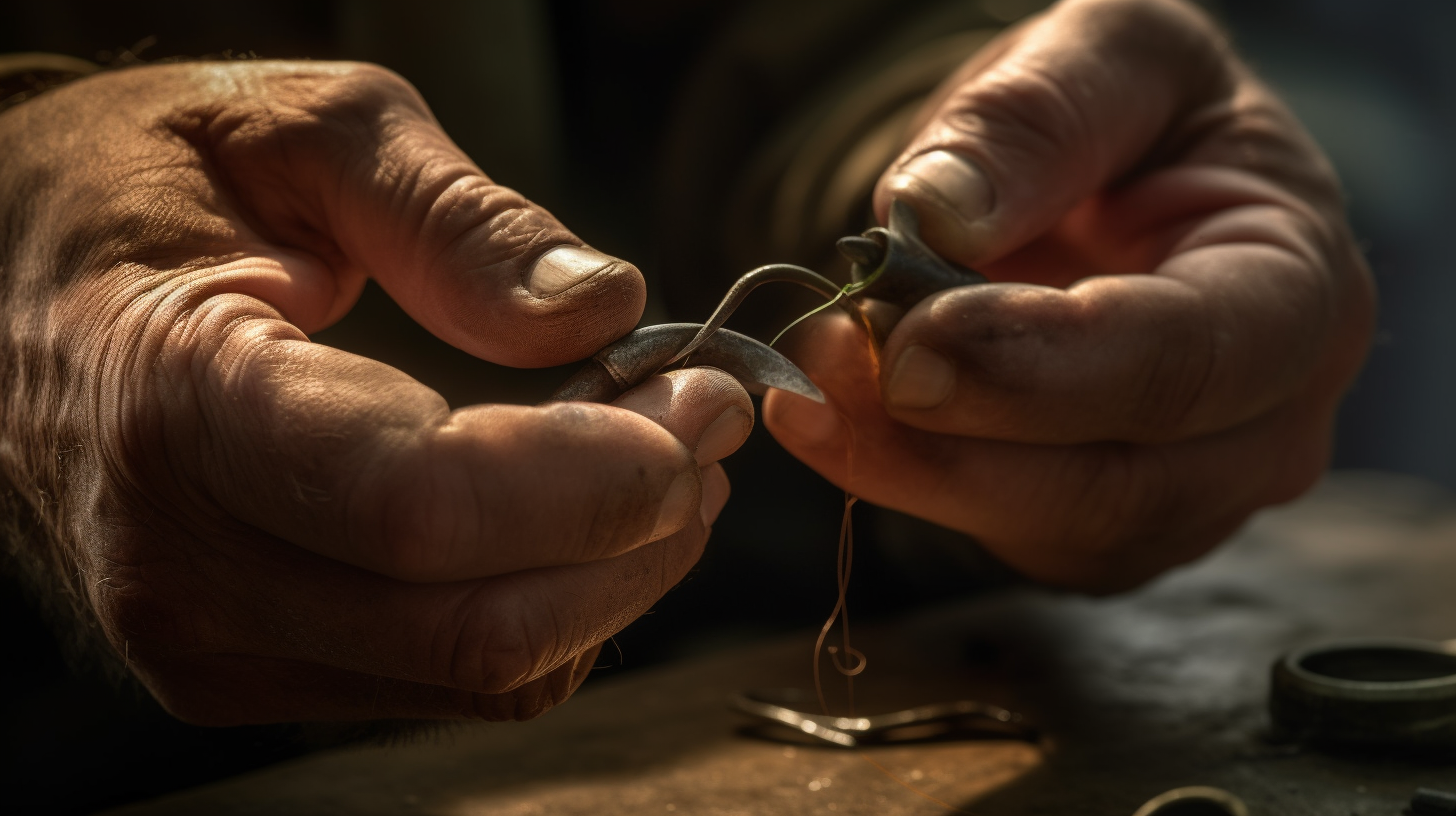Ah, the art of tying fishing line to a hook. It may seem like a mundane task, but let me tell you, my fellow angler, it holds the key to our freedom on the open waters.
As we cast our lines, we yearn for that moment of connection with the elusive fish, and it all begins with a secure knot. So, allow me to guide you on this journey of mastery, where precision and attention to detail are our allies.
Now, before we embark on our quest, we must first understand the importance of choosing the right knot for the job. There are countless variations out there, each with its own strengths and weaknesses. Fear not, for I shall reveal the secrets of the most reliable knots that will keep your hook firmly attached to the line.
So, let us embark on this journey together, my fellow angler, and unlock the gateway to the liberation of the fishing line.
Key Takeaways
- The improved clinch knot and Palomar knot are popular choices for tying fishing line to a hook.
- The type of fishing and fish being targeted should be considered when choosing a knot.
- Gathering the necessary equipment, including the right fishing line and hook, is important.
- Threading the line through the hook eye and properly tightening and securing the knot are crucial steps in creating a strong and reliable connection.
How to Tie Fishing Line to a Hook: A Step-by-Step Guide
Tying a fishing line to a hook is a fundamental skill every angler should master. Whether you’re a beginner or an experienced fisherman, having a secure knot ensures your bait stays attached to the hook and increases your chances of landing a catch. In this step-by-step guide, we’ll walk you through the process of tying two popular fishing knots: the Improved Clinch Knot and the Palomar Knot.
Materials Needed:
Before you begin, gather the following materials:
- Fishing pole with line and reel
- Fishing hook
- Scissors or line cutter
Knot 1: Improved Clinch Knot
The Improved Clinch Knot is a reliable and straightforward knot for securing the fishing line to the hook.
Step 1: Thread the Line
- Start by threading the end of your fishing line through the eye of the hook. Allow about 6 to 8 inches of line to work with.
Step 2: Create a Loop
- Hold the hook with one hand and use the other hand to bring the tag end of the line back, creating a loop alongside the hook shank.
Step 3: Wrap the Line
- Take the tag end of the line and wrap it around the main line and the hook shank about 5 to 7 times.
Step 4: Thread Through the Loop
- Insert the tag end through the loop you created in Step 2.
Step 5: Tighten the Knot
- Hold the tag end and the main line, then pull them simultaneously to tighten the knot around the hook.
- Once the knot is snug, trim the excess tag end with scissors or a line cutter.
Knot 2: Palomar Knot
The Palomar Knot is known for its strength and is an excellent choice for tying hooks, especially with braided fishing line.
Step 1: Double the Line
- Double about 5 to 6 inches of the fishing line and pass it through the eye of the hook. You’ll have a loop on one side and the tag end on the other.
Step 2: Tie an Overhand Knot
- Tie a simple overhand knot with the doubled line, but don’t tighten it completely.
Step 3: Thread the Hook
- Take the loop and pass it over the hook, sliding the hook through the loop.
Step 4: Tighten the Knot
- Gently pull both the standing line and the tag end to tighten the knot around the eye of the hook.
- Once the knot is secure, trim the excess tag end.
Tips for Both Knots:
- Wet the line with saliva or water before tightening the knots. This reduces friction and ensures the knot cinches smoothly.
- After tying the knot, give it a firm pull to test its strength before casting.
Congratulations! You’ve learned how to tie two essential fishing knots for attaching your fishing line to a hook. With these knots in your arsenal, you can confidently bait your hook and get ready for an exciting fishing adventure. Remember, practice makes perfect, so spend some time mastering these knots, and you’ll be a skilled angler in no time!
Choose the Right Knot for the Job
Now, it’s time for you to choose the perfect knot for the job that will ensure your hook stays securely attached to your fishing line, leaving you feeling confident and ready to reel in the big one.
There are different types of fishing knots you can use, each with its own pros and cons. One popular choice is the improved clinch knot. It’s easy to tie and provides a strong hold, making it suitable for a variety of fishing situations.
Read More OutdoorGoodness Articles
Another option is the Palomar knot, which is known for its simplicity and reliability. It’s a great choice when you need to tie on a new hook quickly. However, it may not be as strong as some other knots, so keep that in mind when choosing.
When deciding on the right knot, consider the type of fishing you’ll be doing and the fish you’re targeting. Some knots work better for certain situations, such as when using braided line or fishing in heavy cover. It’s important to understand the strengths and weaknesses of each knot to make an informed decision.
Gathering the necessary equipment for tying your chosen knot is the next step in mastering the art of attaching a hook to your fishing line.
Gather the Necessary Equipment
First things first, make sure you’ve got all the gear you need to start reeling in the big one! When it comes to tying fishing line to a hook, having the right equipment is crucial. Here are three items you’ll need to gather before you begin:
- Fishing Line: There are different types of fishing lines available, such as monofilament, fluorocarbon, and braided lines. Each type has its own unique properties and uses. Monofilament is a versatile choice that works well for most fishing situations. Fluorocarbon lines are known for their invisibility underwater, making them ideal for clear water conditions. Braided lines are incredibly strong and have a high sensitivity, making them great for fishing in heavy cover or for catching larger fish.
- Fishing Hook: Choose a hook that matches the size and type of fish you’re targeting. Hooks come in various sizes and styles, such as circle hooks, J-hooks, and treble hooks. Circle hooks are popular for catch-and-release fishing as they’re designed to hook the fish in the corner of the mouth, minimizing harm. J-hooks are versatile and work well for a wide range of fishing techniques. Treble hooks, with their three points, are commonly used in lure fishing.
- Scissors or Nail Clippers: Having a sharp pair of scissors or nail clippers is essential for cutting the fishing line cleanly and precisely. Avoid using dull scissors or tools that may fray or damage the line. Keeping your line in good condition is important for maximum strength and performance.
Now that you have all the necessary gear, let’s move on to the next step: threading the line through the hook eye.
Thread the Line Through the Hook Eye
Once you’ve gathered the necessary equipment, it’s time to skillfully thread the fishing line through the tiny eye of the hook. This step is crucial in ensuring that your fishing line is securely attached to the hook, allowing you to cast your line and reel in your catch without any worries. To help you visualize the process, let me paint a picture for you:
| Step | Description |
|---|---|
| Step 1 | Hold the fishing line between your thumb and index finger, making sure that there is enough line to work with. |
| Step 2 | With your other hand, grasp the hook firmly, positioning it so that the eye is facing up. |
| Step 3 | Carefully insert the end of the fishing line through the eye of the hook, ensuring that it goes in smoothly and without any twists. |
| Step 4 | Once the line is through the eye, pull it tight to ensure a snug fit. |
By following these steps, you will be able to tie your fishing line correctly and securely to the hook’s eye. Now that you have threaded the line through the hook eye, it’s time to move on to the next step: tying the knot.
Tie the Knot
To tie the knot when threading the line through the hook eye, there are four key steps to follow.
First, form the initial loop by creating a small loop with the line in your hand.
Next, wrap the line around the hook shank, ensuring a tight and secure wrap.
Then, pass the line through the loop, making sure it goes under and through the loop.
Finally, tighten and secure the knot by pulling both ends of the line until the knot is snug against the hook eye.
By following these steps, you can confidently tie your fishing line to the hook and ensure a strong and reliable connection.
Form the Initial Loop
As you’re getting ready to tie your fishing line to a hook, you’ll want to start by forming the initial loop. This step is crucial in creating a strong and secure knot that will hold your hook in place. To form the initial loop, follow these simple steps:
- Hold the end of your fishing line in one hand and create a loop by crossing the line over itself.
- With your other hand, take the tag end of the line and pass it through the loop you just created.
- Pull the tag end tightly to close the loop, ensuring that it is snug but not too tight.
By forming this initial loop, you are creating the foundation for tying your fishing knot. It is important to note that there are different types of fishing knots that you can use, depending on your specific fishing needs. The type of knot you choose will depend on factors such as the type of fishing line you are using and the size of the hook. Therefore, it is essential to practice tying different knots and familiarize yourself with their strengths and weaknesses.
Now that you have formed the initial loop, you are ready to move on to the next step, which is wrapping the line around the hook shank. This is an important part of the process as it ensures that the line is securely attached to the hook.
Wrap the Line Around the Hook Shank
Now, take hold of the end of your line and wrap it tightly around the shank of the hook, ensuring a secure connection that will make your heart race with anticipation for the fish to bite. Proper hand positioning is crucial at this stage.
Hold the hook firmly in one hand while using the other hand to wrap the line around the shank. This will provide stability and control, allowing you to execute the technique with precision. As you wrap the line around the hook shank, make sure to maintain tension by gently pulling the line with your fingers. This technique ensures that the line is securely wrapped around the hook, preventing it from slipping or unraveling.
To maintain tension effectively, there are a few techniques you can try. One technique is to use your index finger and thumb to pinch the line against the hook shank. This allows you to control the tension and ensure a tight wrap. Another technique is to use your other hand to hold the line taut while wrapping it around the hook shank. This method provides additional tension and stability, ensuring a secure connection. Lastly, you can also wrap the line around the hook shank multiple times to increase the tension. This creates a stronger connection and reduces the risk of the line coming loose.
With the line securely wrapped around the hook shank, you are now ready to move on to the next step: passing the line through the loop. This crucial step will further secure the connection and prepare you for a successful fishing experience.
Pass the Line Through the Loop
Using my nimble fingers, I effortlessly thread the line through the loop, creating a seamless connection that will leave even the most experienced angler in awe. This step in tying a fishing knot is crucial, as it ensures that the hook is securely attached to the line.
When it comes to choosing the right fishing hook, there are various types available, each with its own specific use. For example, a worm hook is perfect for rigging soft plastic baits, while a treble hook is ideal for catching fish with multiple points of attachment. It’s important to consider the type of fish you’re targeting and the bait you’re using to determine the most suitable hook.
While tying a fishing knot, there are common mistakes that should be avoided to ensure a strong and reliable connection. One of these mistakes is failing to wet the line before tightening the knot. Wetting the line reduces friction and allows for a smoother knot, preventing weakening or breakage. Another mistake is not properly seating the knot against the hook eye. This can result in an uneven distribution of pressure, causing the knot to slip or unravel. By being mindful of these mistakes and taking the time to tie the knot correctly, you can ensure a secure connection that will withstand the challenges of reeling in your catch.
Now that the line is securely threaded through the loop, it’s time to move on to the next step of tightening and securing the knot.
Tighten and Secure the Knot
Ensure a strong and unyielding connection by firmly cinching and locking down the knot. To achieve this, it’s vital to understand the importance of using the correct fishing line strength.
Using a fishing line that’s too weak can result in the line breaking when you reel in a fish, causing you to lose your catch. On the other hand, using a line that’s too strong can make it difficult for the fish to bite and feel the bait, decreasing your chances of a successful catch. Therefore, it’s crucial to choose a fishing line that matches the type of fish you’re targeting and the conditions you’ll be fishing in.
When tying the fishing line to the hook, there are some common mistakes that you should avoid. One mistake is not properly wetting the line before tightening the knot. Wetting the line reduces friction and allows the knot to tighten more smoothly. Another mistake is not pulling the knot tight enough. A loose knot can easily come undone, leading to a lost fish. Finally, make sure to trim any excess line after tying the knot. Excess line can interfere with the bait’s movement and increase the chances of tangling or snags.
Now that we’ve firmly cinched and locked down the knot, it’s time to test its strength.
Test the Knot
Once you’ve tied the knot, you’ll be good to go and ready to reel in the big one! But before you cast your line, it’s important to test the knot to ensure its durability. There are different types of tests you can perform to make sure your knot is secure and won’t let you down when it matters most.
One way to test the knot is to give it a gentle tug. Pull on the line to see if the knot holds tight. If it slips or comes undone, you’ll need to retie it before you can start fishing. Another test you can perform is the “wet test.”Wet the knot and then pull on the line to simulate the strain it will experience when you have a fish on the line. This will give you a good idea of whether the knot will hold up under pressure. Additionally, you can perform a stress test by pulling on the line with increasing force to see at what point the knot begins to fail. By conducting these tests, you can have confidence in the strength and reliability of your knot, giving you the freedom to fish without worrying about losing your catch.
| Test Type | Procedure |
|---|---|
| Gentle Tug | Pull on the line to see if the knot holds tight. Retie if it slips or comes undone. |
| Wet Test | Wet the knot and pull on the line to simulate the strain it will experience when reeling in a fish. |
| Stress Test | Pull on the line with increasing force to determine the knot’s breaking point. |
| Final Check | Ensure the knot is securely tied and ready for fishing. |
By following these testing methods, you can be sure that your knot is strong and will withstand the challenges of fishing. So go ahead and cast your line with confidence, knowing that you’ve taken the necessary steps to ensure your knot is secure. Happy fishing!
Frequently Asked Questions
How do I choose the right fishing line for different types of fishing?
To choose the right fishing line for different types of fishing, consider the fishing line selection based on the specific fishing techniques you plan to use. Understanding the various types of lines and their characteristics is essential for successful fishing adventures.
What are the common mistakes to avoid when tying a fishing knot?
To ensure a strong and secure fishing knot, it’s crucial to avoid common mistakes. Understanding the proper technique is key. Let me share my knowledge and provide detailed instructions to help you achieve fishing freedom.
Are there any alternative methods for threading the line through the hook eye?
There are alternative methods for threading the line through the hook eye. One of the most beneficial techniques is using a loop knot. It provides more freedom of movement for the bait, increasing the chances of catching fish.
How can I ensure that the knot is secure and won’t unravel while fishing?
To ensure your knot won’t unravel, it’s crucial to choose the right fishing knot. Some popular options include the improved clinch knot and the Palomar knot. Remember to wet the line before tightening for maximum strength.
How often should I test the knot during a fishing session to prevent losing a catch?
I re-tie my knot during a fishing session whenever I notice any signs of weakness, such as fraying or looseness. It’s important to constantly check the knot to ensure it won’t unravel and cost me a catch.
Conclusion
In conclusion, tying fishing line to a hook requires the right knot, the necessary equipment, and a steady hand. It may seem like a simple task, but it’s one that requires precision and attention to detail. By choosing the right knot for the job, such as the improved clinch knot or the Palomar knot, you can ensure that your line will stay secure and your hook will stay in place.
Gathering the necessary equipment, such as a fishing line and a hook, is essential before attempting to tie the knot. Make sure the line is strong and durable, and that the hook is sharp and ready for action. Once you’ve threaded the line through the hook eye, it’s time to tie the knot. Take your time and follow the steps carefully, making sure to tighten the knot securely.
Finally, test the knot by giving it a gentle tug to ensure it’s holding strong.
Tying fishing line to a hook may seem like a small task, but it’s one that can make all the difference in your fishing success. By mastering the art of tying a strong and secure knot, you can increase your chances of landing that big catch. So next time you head out to the water, remember to choose the right knot, gather the necessary equipment, and tie the knot with precision.
Happy fishing!

Meet Kevin Goodell, your outdoor adventure coach! With a passion for nature ignited in childhood, Kevin brings a wealth of experience and expertise to simplify tough outdoor skills. As a U.S. Army veteran and former Sergeant, he has honed his leadership and teamwork abilities while developing a deep love for the great outdoors.
Kevin’s dedication to outdoor activities spans biking, birdwatching, national park trips, and archery/golf. With his friendly and approachable demeanor, he is committed to guiding individuals of all ages and skill levels towards unforgettable outdoor experiences.
Harnessing his extensive knowledge and personal achievements, Kevin is your go-to resource for learning and enjoying various outdoor pursuits. Whether you seek thrilling adventures or serene nature escapes, Kevin’s professional yet friendly approach will ensure an engaging and informative experience. Embark on your next outdoor adventure with Kevin Goodell and embrace the beauty of nature like never before.






